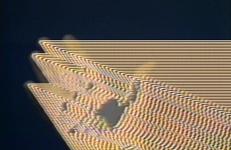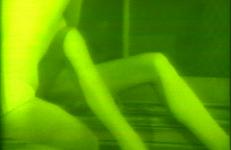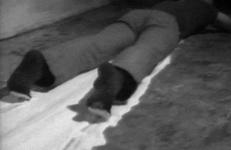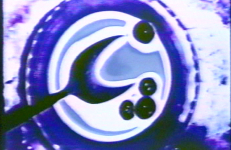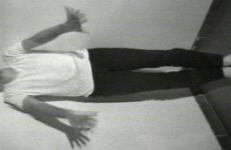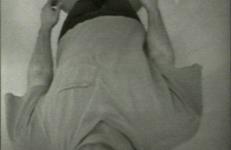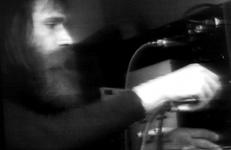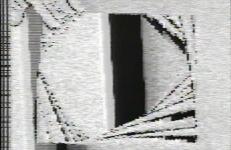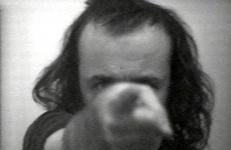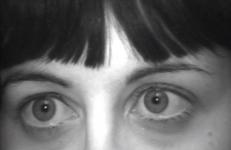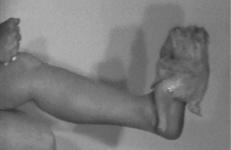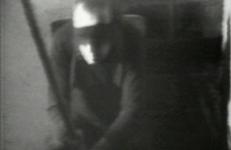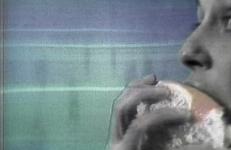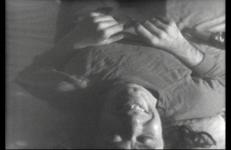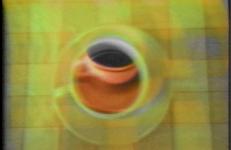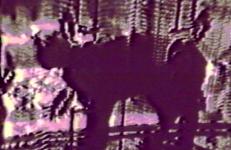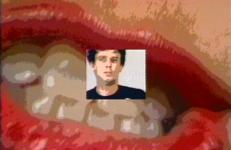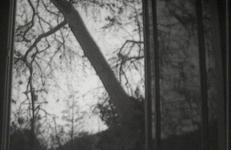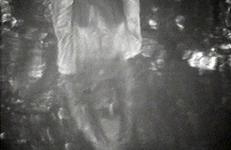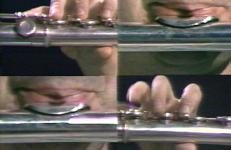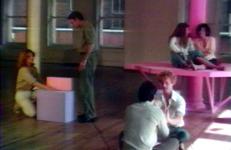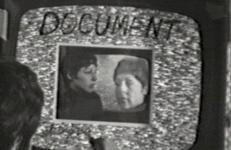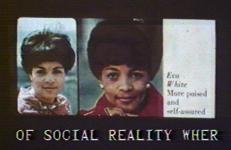In 1964, Steina Vasulka (then Steinunn Bjarnadottir) married Woody Vasulka, a Czech engineer with a background in film. They later moved to New York where, with Andreas Mannik, they founded the Kitchen, a performance space dedicated to new media. The Vasulkas collaborated on a series of video works whose imagery arose primarily through the manipulation of the video signal at the level of the electron beam itself.
Video History
The male/female, subject/object investigation in A Bit of Matter and a Little Bit More has no titillating introduction; the appetite is not whetted beforehand. Hardcore, the opening shot, shows the crotch areas of a male and female body engaged in coitus. At the end of the tape a male voice says, "Some questions and five answers relative to moved pictures, five questions and some answers relative to moved pictures—" a reference to the artists' book, 100 Rocks on a Wall.
Black and White Tapes derive from a series of performances Paul McCarthy undertook in his Los Angeles studio from 1970 to 1975. Conceived for the camera and performed alone or with only a few people present, these short performances use video to articulate both monitor and studio space. In the first excerpt, McCarthy paints a white line on the floor with his face, dragging his body from one end of the studio to the other. In doing so, McCarthy performs a recognizable formal gesture--drawing a white line.
"An electronic synthetic color video, based on a memory of Larry Gottheim's film Blues. Natural and electronic real time events, new American electronic cinema. B&W video camera, Paik-Abe colorizer, 1/2" vtr, blue berries, bowl and milk. The filmmakers stopped talking to me. Viva Video!"
– Peer Bode
This is a tape which analyzes its own discourse and processes as it is being formulated. The language of Boomerang, and the relation between the description and what is being described, is not arbitrary. Language and image are being formed and revealed as they are organized.
This title is only available on Surveying the First Decade: Volume 1.
Nauman is seen standing and leaning back in a corner of his studio. Just as he bounces back to a standing position, his body falls again, momentarily collapsing, only to spring forward once more. This action places his body in an intermittent space, occupying a position halfway between standing and leaning, halfway between the wall and the room.
This title was in the original Castelli-Sonnabend video art collection.
Repeating the same activity as featured in Bouncing in the Corner, No. 1—leaning back and bouncing forward from the corner—this time the camera is positioned just above Nauman’s head. This gives his body the sense of constantly rising and falling, his chin just crossing the bottom edge of the screen before sinking back.
This title was in the original Castelli-Sonnabend video art collection.
In this video the artist states that a public work demonstrates what qualifies as art within his conception. Like Beached, it was also shot in a marshy area near the sea and in sequences separated by dissolves. One sees five different actions related to Broken Off. The artist breaks a tree branch, scrapes and kicks the ground with his foot, snaps a stick in two on a fence, scrapes a stone with his fingernail. At the end he pulls the line plug from the video, drawing attention to the mechanics of the medium.
"We buried ten Cadillacs in a row alongside Interstate 40 (the old Route 66), just west of Amarillo, Texas; each car represented a model change in the evolution of the tail fin. This was clearly a sculptural act, but with a minimal amount of formal manipulation. Media Burn, created a year later in San Francisco, was a live performance. It was a spectacle staged for the camera culminating in the 4,000 pound Phantom Dream Car crashing through a pyramid of TV sets to the cheers of the audience of 400.
"The Camel with Window Memory piece was made one weekend in the early '80's. I pulled out my post card collection and began to look at specific postcards run through the new digital video buffer I had built together with David Jones. The buffer had only one frame of memory but it was real time. It had the capability of displaying the image memory space, either as live or frozen.
"Pointing at my own image on the video monitor: my attempt is to keep my finger constantly in the center of the screen — I keep narrowing my focus into my finger. The result [the TV image] turns the activity around: a pointing away from myself, at an outside viewer."
— Vito Acconci, "Body as Place-Moving in on Myself, Performing Myself," Avalanche 6 (Fall 1972)
Unhinging the narrative conventions and stereotypical elements of the whodunit occult thriller, Chained Reactions is an update of film noir style. Calling on the cliches of gothic romance novels and television soap operas, Chained Reactions presents an increasingly dense collage of symbolic, absurd, and everyday images and gestures, challenging the viewer to find the associative meanings that link them. The soundtrack, composed of whispers, music, and sound effects, sets a suspenseful, unresolved tone.
In Chicken on Foot, Sobell bounces a chicken carcass as one would a child, periodically crushing eggs (fetal chickens) on her knee. A statement of the displacement of sexual desire on food and women’s bodies, and an expression of female ambivalence about motherhood.
"In this record of a live performance, Acconci gives physical manifestation to the subterranean regions of the artist’s mind and will, revealing the effort he must make as an artist to simultaneously convince himself and his audience. Perhaps no other piece from the early 1970s more thoroughly spells out the psychologized drama engendered by performance-based video....
Three basic compositions are played and recombined in Collage: a hockey game; arms swinging across the screen; and a hand holding one, two, then three oranges. As in her other work, Benglis plays with several generations of each shot, rescanning the screen, and placing objects in front of the monitor. Organized around color and rhythm, each segment uses bright colors, rapid movements, and complex layers of images to present a mesmerizing compendium of information that frustrates any sense of narrative.
Torn over the pressure to perform for his audience, Acconci fantasizes about "a dancing bear" who takes his place, performing in the spotlight, doing what others want, "what I always had to do." The viewer is placed in the position of an authority or analyst, above Acconci’s head, listening to his hallucination. This fantasy becomes increasingly erotic as Acconci unburdens himself psychologically and reveals his contradictory need to control and to be controlled.
This title was in the original Castelli-Sonnabend video art collection.
"A cup and saucer, pouring and drinking coffee, a duration ritual of contemplation and invigoration, doubled (tape copied), mixed, keyed + synthetic color, normal play and rewinding, sync events, the opening of a space to put the self in. 1/2 inch b+w Portapack, 2 reel to reel video tape decks, David Jones keyer and colorizer."
– Peer Bode
In this video, the unseen narrator describes her inability to communicate to the camera what she wants to say and to whom she wants to say it. The curtain is the central metaphor for the piece, representing how Latham hides behind the video medium, as well as how the medium presents an obstacle to the artist, functioning as a cumbersome intermediary to expression.
This title is also available on Barbara Latham Videoworks: Volume 1.
An insert square of a man running is superimposed over a magnified mouth that speaks to him — first in nurturing encouragement, then with a no-win Mommie Dearest kind of criticism. Originally presented as an installation on six monitors, Deadline focuses on “the stress man feels in the urban environment,” using a range of digital video effects to stretch, compress, flip and fracture the image.
This structurally simple video, shot through Benglis's apartment window, contains a, "distinct disjuncture between the visual and aural components of the work. The viewer, initially presented with a contemplative view of nature, is frequently distracted by the chatter of a radio. As the camera zooms in and out, it establishes a dichotomy: indoors and outdoors, the man-made and the natural.
Jonas uses reflections on a lake as a mirror to displace reality, creating a disruption and the illusion of presence.
“Disturbances begins with a Symbolist-like image of two women, dressed in white, seen only as reflections in water.… Throughout the tape the water fills the monitor, creating layers of images. The reflections on the surface of the water are superimposed on the activities that take place underneath the surface.”
Utilizing a four-way split screen, Divided Alto documents Landry’s improvised flute performance—focusing on the harmonics of the instrument as he plays double and triple chords. The camera centers on the elements that make the music—the mouth and fingers of the musician—as the music moves from counterpoint to synchronization, establishing rhythms that ebb and resurface. The tape is double-tracked in stereo, video, and audio.
The performers are seated around a pink octagonal table on pink, violet, and silver cinder blocks. One performer (Robert Stearns) stands up, recites the credits for the piece, and then says, “Do you believe in water? Robert Stearns.” He claps and turns to the next performer who asks the same question and gives his name. Next the players split up into pairs and attempt to relate to each other—playing tug-of-war, making love, arguing over who has the most integrity, and fighting for possession of the props.
With Benglis standing in front of a photograph of herself, which is then affixed to a monitor bearing her image, the notion of "original" is complicated—making the viewer acutely aware of the layers of self-images and layers of "self" that are simultaneously presented. Like Martha Rosler's Vital Statistics of a Citizen, Simply Obtained, Benglis presents the viewer with a "document" of questionable veracity. It is a document attesting not to the "real" Benglis, but to the impossibility of discerning one real identity.
Rosler calls Domination and the Everyday, with its fragmented sounds, images, and crawling text, an artist-mother's This Is Your Life. Throughout this work, we hear—but do not see—a mother and small child at dinner and bedtime while a radio airs an interview with a gallerist about Californian art of the 1960s. The soundtrack moves into overdrive with feedback, a passing train, barking dogs, and a bedtime story. The visuals, all still images, are drawn from television, movies, advertising, and the family album.




